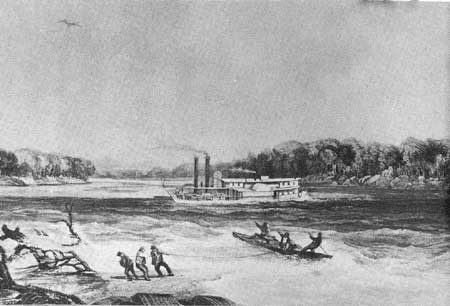|
The Upper Missouri Fur Trade Its Methods of Operation |
 |

Steamboat "Yellowstone"
Much of the routine work of the early trade was conducted by the engagees or voyageurs. They represented many different nationalities, half breeds, mulattoes, and negroes and came for the most part from St. Louis. The Canadians were in majority. The engagees were called "mangeurs de lard" or "pork eaters" because most of them were imported from Canada and in the course of their trip from that country lived largely on a diet of pork, hard bread and pea soup. Prior to the use of the steamboat, many of these "pork eaters" used to man the keelboats on their trips up the river. Kurz wrote in 1851 that a craftsman or work man received $250 a year, a workman's assistant $120 or less and a hunter $400, together with the hides, and the interpreter who, unless otherwise occupied, seldom received more than $500. [51]
Above the engagees were the clerks and the bourgeois. The work of the clerks appears to have varied but seems to have been principally the supervision of the normal operations of the post. Charles Larpenteur's first assignments as clerk at Fort Union in 1834 were opening the gates of the post early in the morning and closing them at night, seeing that the horses and tools were in order and kept in their proper places, and helping with the stores. Later, he supervised the rebuilding and new construction of the fort, the gardening and the supplying of wood for the post. Kurz, the clerk at the same post in 1851-1852, was irritated with his duties. Because of the sore thumb of the bourgeois, he was required to serve as his secretary. Kurz complained:
. . . He [Denig] is vexed if I cannot account for every rope, every nail, tool, implement, stock, ring, saddle, nay, even every mouse in the fort. I am to keep a sharp lookout in all directions, so as to know what is in stock, what is wanting, what is out of place; I am to know from actual observation everything, even to the smallest objects, that is stored in the attic under the roof, in boxes and chests, in barrels and casks, in the cellar, in places to which I am not admitted, in outhouses, even among dungheaps in a stall; for shovels and hose or something else may be left lying there neglected or forgotten. . . . [52]
The clerk's salary seems to have varied according to his length of service and the responsibility of the position. In 1834 the American Fur Company engaged inexperienced clerks for a three year period for $500 and a complete suit of clothes of fine broadcloth. Larpenteur, who had some experience, was employed in 1834, for the first year, for $250 and a suit of clothes. For his second year he received $350. Kurz wrote in 1851-1852 that the clerks and traders who had a knowledge of the Indians at the particular post at which they were stationed, commanded a salary from $800 to $1000 a year. [53]
The wages given the employees were comparable to those paid in the States. Most of them bought on credit from the company at exorbitant prices and seldom laid anything away. Many married. The bourgeois endeavored to bind the more capable ones for another year, by advancing them sums and goods on credit. However, since the company furnished both board and lodging, an employee could, under certain conditions, as Kurz pointed out, save almost his entire income. He "must have on hand a supply of clothing, must be content with the fare of the fort, indulge in no dainties or feasting, and never allow himself to come within 10 feet of the Indian women." [54]
There was a caste system at the larger posts such as Fort Union and social amenities were observed. Clerks and the bourgeois were served at the first table which was furnished with such luxuries as flour, bread, bacon, cheese, butter and milk. The bourgeois sat at the head of the table, on which was spread a white tablecloth and was attended by waiters. The employees were seated in accordance to rank. [55] Kurz wrote in 1851, "We have meat, well selected, bread, frequently soup and pie on Sundays." [56] The mechanics, hunters, and workmen ate at a second table with meat, biscuit, black coffee and sugar.

|

|
|
|
|
Last Modified: Sat, Jan 15 2005 10:00:00 am PDT |


